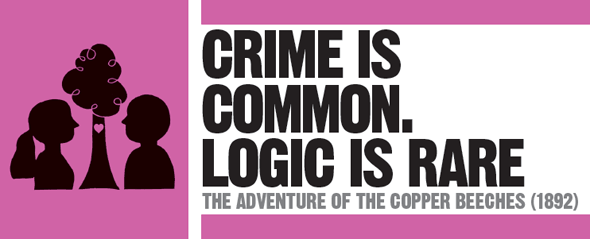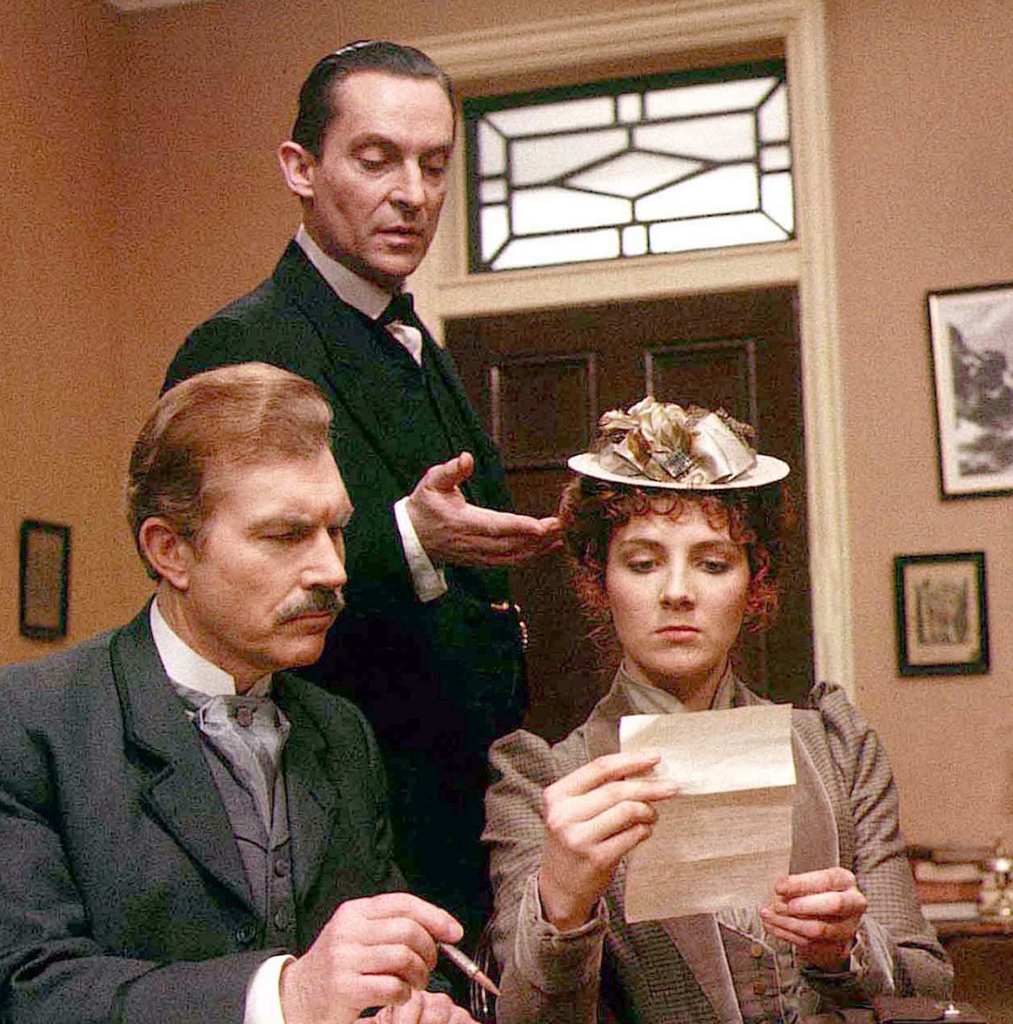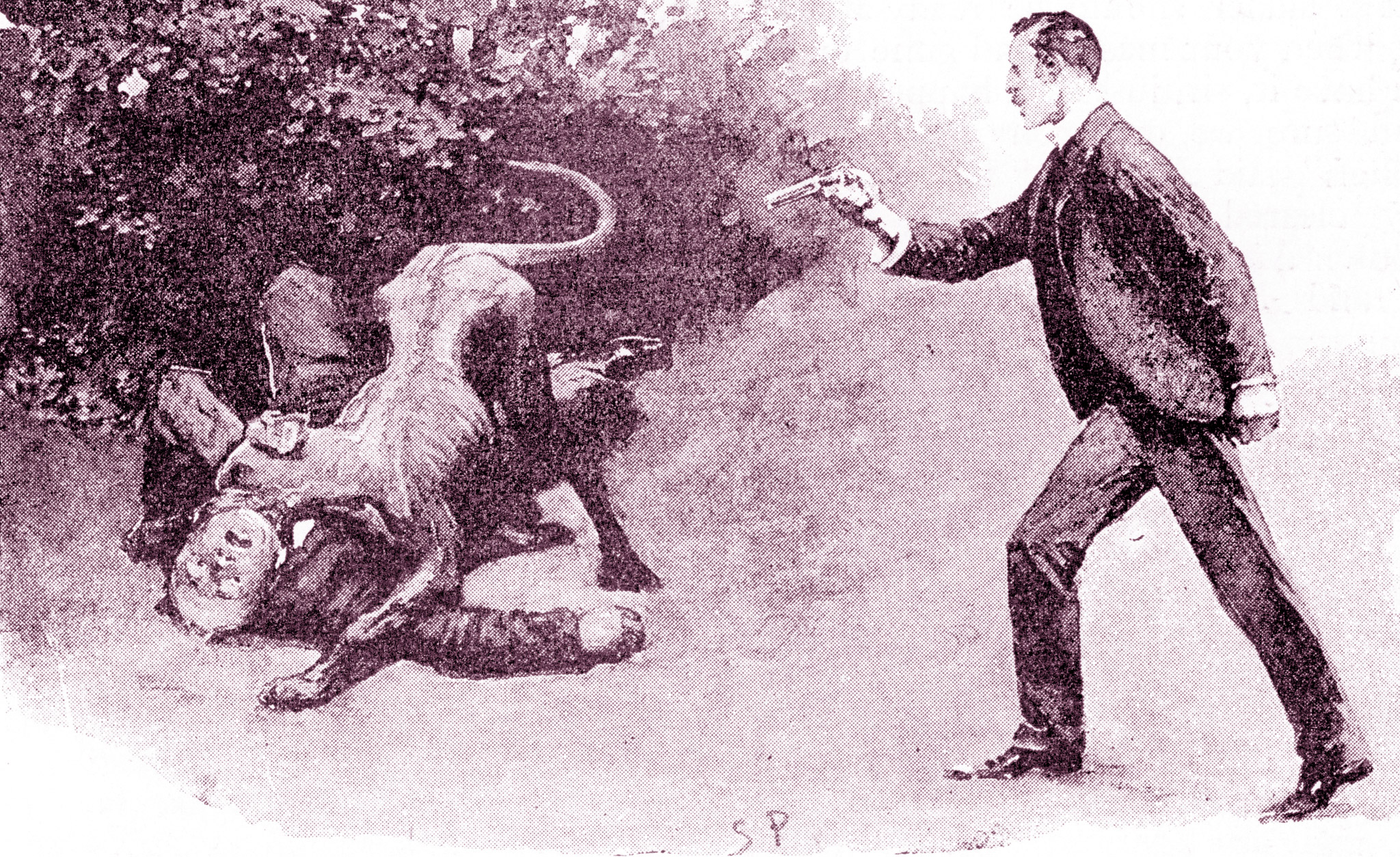
IN CONTEXT
Short story
UK: June 1892
The Adventures of Sherlock Holmes, 1892
Violet Hunter Young governess.
Jephro Rucastle Middle-aged landowner.
Mrs. Rucastle Jephro’s second wife.
Alice Rucastle Jephro’s daughter by his first wife.
Toller and Mrs. Toller The Rucastles’ servants.
Mr. Fowler Alice’s fiancé.
Along and unusually revealing scene about Holmes’s and Watson’s relationship opens “The Adventure of the Copper Beeches.” Holmes takes Watson to task about the way he writes about him in his memoirs, accusing the doctor of embellishing his reports with literary flourishes rather than simply detailing the detective’s skill, and turning “a course of lectures into a series of tales.” Indeed, it seems that the legendarily inscrutable Holmes is in a bad mood—and the famously placid Watson is quite offended and “repelled by the egotism” of his friend.
In a playful, self-referential manner, Conan Doyle has fun with the reader, and even has Holmes criticize the quality of the writing. It is so adroitly done that the reader almost forgets that Watson and Holmes are fictional characters, and Watson is not a real person writing about a real detective.
Holmes in a bad mood
Conan Doyle is clearly setting up the idea that something is preying on Holmes’s mind. After the spat with Watson, Holmes rues the decline in the quality of the criminal mind, complaining sardonically, “As to my own little practice, it seems to be degenerating into an agency for recovering lead pencils and giving advice to young ladies from boarding-schools.”
For the coolly logical Holmes, this seems strangely like an emotional outburst. It has all been triggered, it transpires, by a letter from a young woman named Violet Hunter, asking for advice on whether to take up a post as a governess, which he tosses to Watson to read. But is Holmes actually rather intrigued by this letter, instead of outraged? He has crumpled up the letter, but it is still in his hand to give to Watson. Does he suspect, as Watson reminds him of “The Adventure of the Blue Carbuncle”, that what may appear at first to be “a mere whim” may turn out to be about something much more interesting?
"The days of the great cases are past. Man, or at least criminal man, has lost all enterprise and originality."
Sherlock Holmes
A peculiar request
Just as Holmes has concluded his rant about the triviality of Miss Hunter’s letter, Violet herself arrives at 221B Baker Street. Watson observes that his friend is immediately attentive and that he is “favourably impressed by the manner and speech of his new client.” This observation may be intended to tantalize the reader into believing that Holmes might become romantically involved with the young woman. Violet confirms that she wants his advice on whether to take up a post as governess for a man named Jephro Rucastle at a house near Winchester called Copper Beeches. But, as Holmes sees at once, there is something more to this case than mere employment advice.
The pay is very good, but Mr. Rucastle has made some strange requests, including that she should cut off her long hair and wear any dress that he or his wife might ask her to put on. She initially rejects the offer, but needs the money and is curious about the situation, so she decides to accept it after all. Although Violet’s mind is made up, she wants Holmes’s opinion on the matter, and is checking whether she can contact him later should anything untoward take place once she starts her new job. Fascinated by this enigmatic scenario, Holmes agrees to her request.
Two weeks after Violet has taken up the position, she telegraphs Holmes, imploring him to meet her in Winchester. The next morning, Holmes and Watson catch the train to see her, and she informs them of the strange progress of events.

Violet Hunter, played by Natasha Richardson in the 1985 ITV adaptation, reads Holmes (Jeremy Brett) and Watson (David Burke) the letter from Mr. Rucastle imploring her to accept his job offer.
Gothic setting
Copper Beeches, it seems, is a strange, rather eerie place. It is clearly Conan Doyle’s intention to ramp up the atmosphere and sense of expectation by bringing all the familiar elements of the classic Gothic horror story into play—a remote location, a gloomy, decaying house, shadowy trees, a savage dog, a morose housekeeper, and—most dramatic of all—a locked room containing a terrible secret.
The late Victorian era was a golden age for Gothic fiction and tales of the supernatural, with novels such as Bram Stoker’s Dracula (1897) capturing the public imagination, and stories of encounters with ghosts and spirits receiving attention as never before. However, in stories such as “The Adventure of Wisteria Lodge” and “The Adventure of the Sussex Vampire”, Conan Doyle takes the tropes of Gothic literature and allows Holmes to show that there is a perfectly rational explanation for each crime. That is why Holmes leads so neatly from the superstitions of the Victorian age to the rationality of the 20th century. Unlike many other fictional characters, he is not looking for evil spirits but for clues to real behavior.
The disturbed child
The emergence of psychology as a scientific discipline in the late Victorian era meant that many people were beginning to believe that to understand the present, you also had to understand the past. There was a shift toward a more scientific study of criminals, with new theories proposing that human behavior could be explained by inheritance and biology gaining wider currency.
So when Violet tells Holmes that the little boy in her charge is morose and cruel, and crushes cockroaches for fun, in a typical Gothic tale this might be a sign that the child is demonically possessed. But Holmes seeks a rational explanation. As he explains to Watson, in the bad behavior of the child he sees warning signs of the true nature of his father, Jephro Rucastle, and he is alerted to the peril Violet may be in.

By looking to the character of Rucastle’s son to gain insight into that of his father, not the other way around, Holmes turns a common way of thinking on its head.
The governess’s story
Violet tells Holmes that she has learned that Rucastle also has a daughter, Alice, from his first marriage, who has gone away to Philadelphia. In her position as governess, Violet has been asked to wear a particularly striking electric-blue dress, and told to sit with her back to the window, either reading out loud or listening to Rucastle’s stories while his wife sits in deadly silence. Sneaking a peek in a mirror one day, Violet glimpsed a mysterious young man watching her from the road.
She recounts other bizarre and unnerving matters—a huge mastiff, which is kept hungry, prowls the grounds at night; she finds a tress of hair very much like her own locked away in a drawer; and, strangest of all, there is a wing of the house kept locked and seemingly empty. Desperate to know what is going on, Violet sneaked into the locked wing and was terrified to see the shadow of someone moving in a barricaded room. Rucastle caught her and threatened to throw her to the dog if she did not curb her curiosity. Genuinely frightened by this, she had sent for Holmes.
"The lowest and vilest alleys in London do not present a more dreadful record of sin than does the smiling and beautiful countryside."
Sherlock Holmes
The secret revealed
Holmes then surmises that Violet has been hired to impersonate Rucastle’s daughter, Alice, who is not in Philadelphia at all but is instead imprisoned in the empty wing. He devises a plan to free Alice when the Rucastles are out that evening. Violet returns to the house, and, following the plan, lures the servant Mrs. Toller into the cellar and traps her there while Mr. Toller is drunk. Holmes and Watson arrive and break into the locked room, only to find it is empty.
Astonishingly, it seems that Alice has been taken out through the skylight. In one of his rare mistakes, Holmes believes that Rucastle has taken her away. At that moment, Rucastle surprises them in the locked wing and dashes out to set the mastiff on them, but the starving hound savages him instead. Watson manages to shoot the dog, but Rucastle is badly hurt.
As Watson tends to Rucastle’s wounds, Mrs. Toller appears and reveals the truth. Alice was the sole beneficiary of her late mother’s will, but she allowed her father to take care of the affairs. Upon meeting her fiancé Mr. Fowler, Rucastle tried to force Alice to sign the inheritance over to him before she married and he lost control of the finances. Distraught, she had an attack of “brain fever,” suffering from the illness for six weeks. Alice recovered, but Rucastle locked her in the chamber. Violet was hired to act as Alice so that Fowler would believe she was well again, but no longer interested in him. Fowler was not put off, however, and it was he who rescued her.

This illustration The Strand Magazine depicts the moment Rucastle is savagely attacked by the huge mastiff.
Holmes the man
Although Holmes is attentive to Violet and seems to admire her, describing her as a “quite exceptional woman,” to Watson’s disappointment Holmes’s brief interest in her is over as soon as the case is solved. Conan Doyle has teased the reader, momentarily hinting that emotion might lurk behind the detective’s coolly mechanical facade.
The tale also reveals Holmes’s somewhat bleak outlook on life. While traveling on the train to Winchester, Watson remarks on the beautiful countryside, dotted with charming farmhouses. Holmes admits that he can see only their desperate isolation in which unspeakable crimes may be concealed. Watson is appalled by his negativity, but the moment hints at the psychological complexity of Holmes that has enthralled readers for so long.
Interestingly, although Holmes says at the start of the story that Watson should tell tales that reveal his deductive powers, here they actually play very little part. Instead, the action is precipitated almost entirely by Violet, with Holmes taking a supporting role.
PRISONERS IN THE HOME
The immense control Victorian men had over their wives and daughters has been the stuff of Gothic horror stories ever since Charlotte Brontë wrote about mad Bertha Rochester being locked in the attic by her husband in Jane Eyre (1847). Legally, families were allowed to keep a family member confined if they were declared insane (to avoid a charge of false imprisonment)—but it was up to the family or a hired “doctor” to diagnose their insanity.
Brontë may have been inspired by a government report in 1844, which revealed shocking cases of the rural poor attempting to look after their unstable family members at home. The reason for the secrecy was partially the deep shame felt about mental illness; however, in some cases families were also trying to save their loved ones from the horrors of lunatic asylums. Nevertheless, many unfortunate people were locked away because of personal grievances or for financial gain. There were certainly many cases of unspeakable cruelty that never saw the light of day, and many others like Alice Rucastle whose terrible suffering remained hidden.
In 1879, the British Medical Journal observed that there was still “no law to prevent a Mr. Rochester from locking up his mad wife in the attic of a mansion, with a keeper.” A rise in awareness followed, and 1890, the year in which “The Copper Beeches” is believed to be set, was the last year in which Rucastle could legally have gotten away with locking up his daughter.
